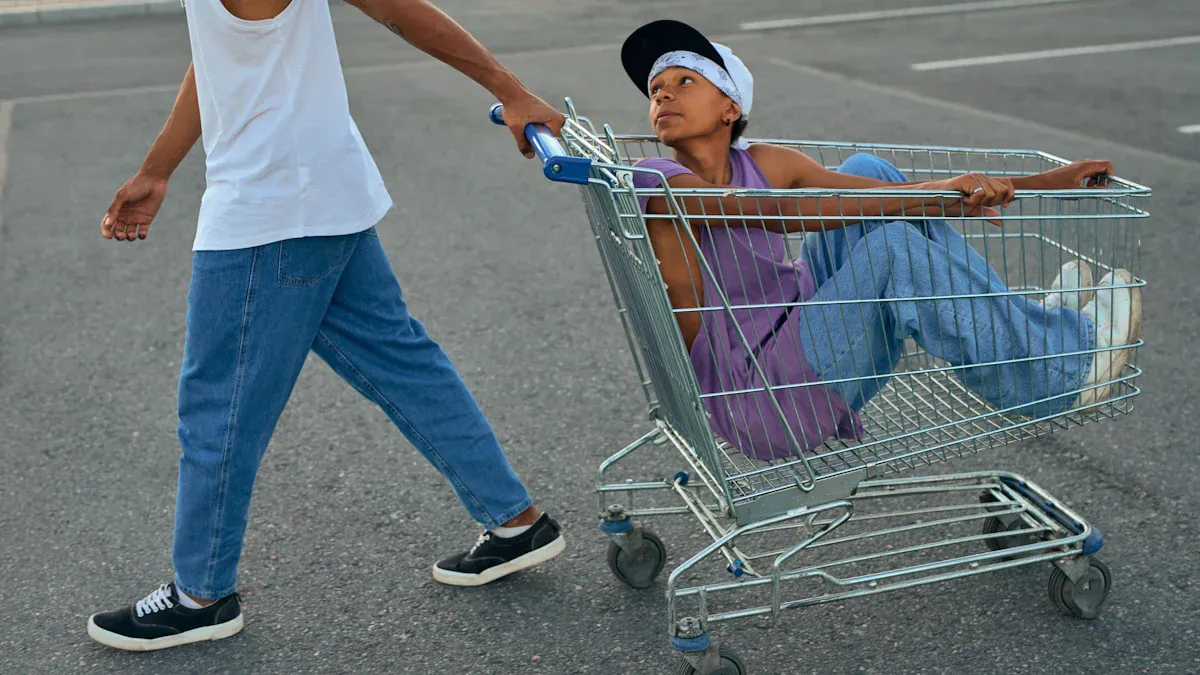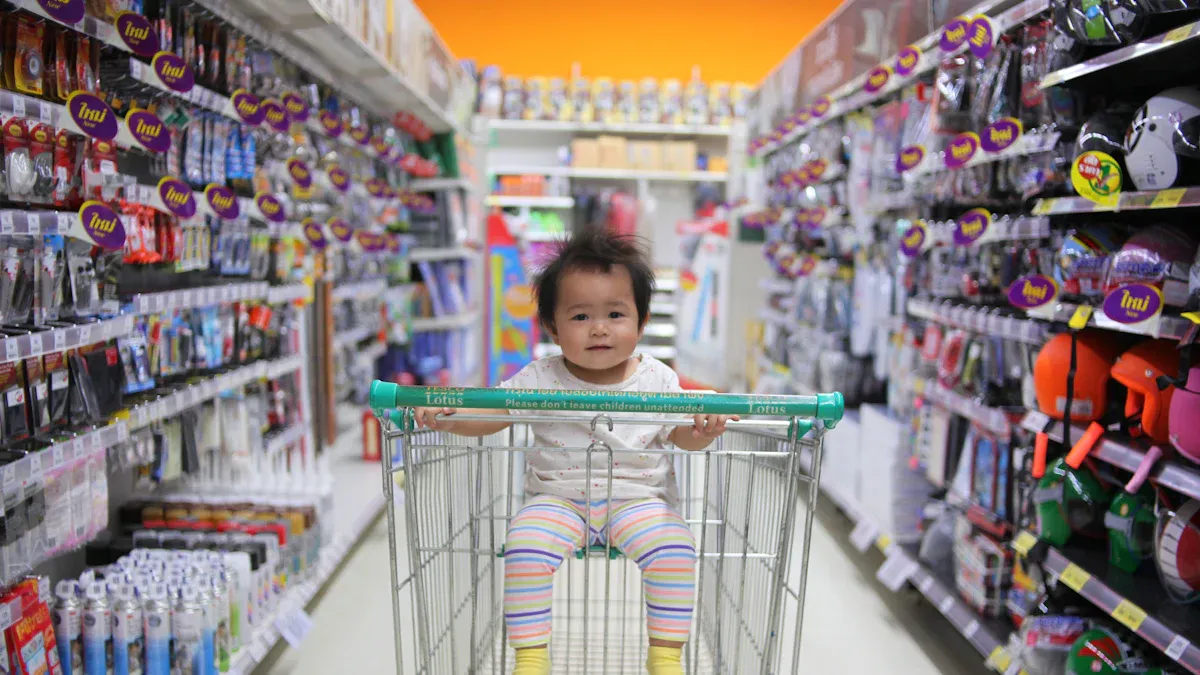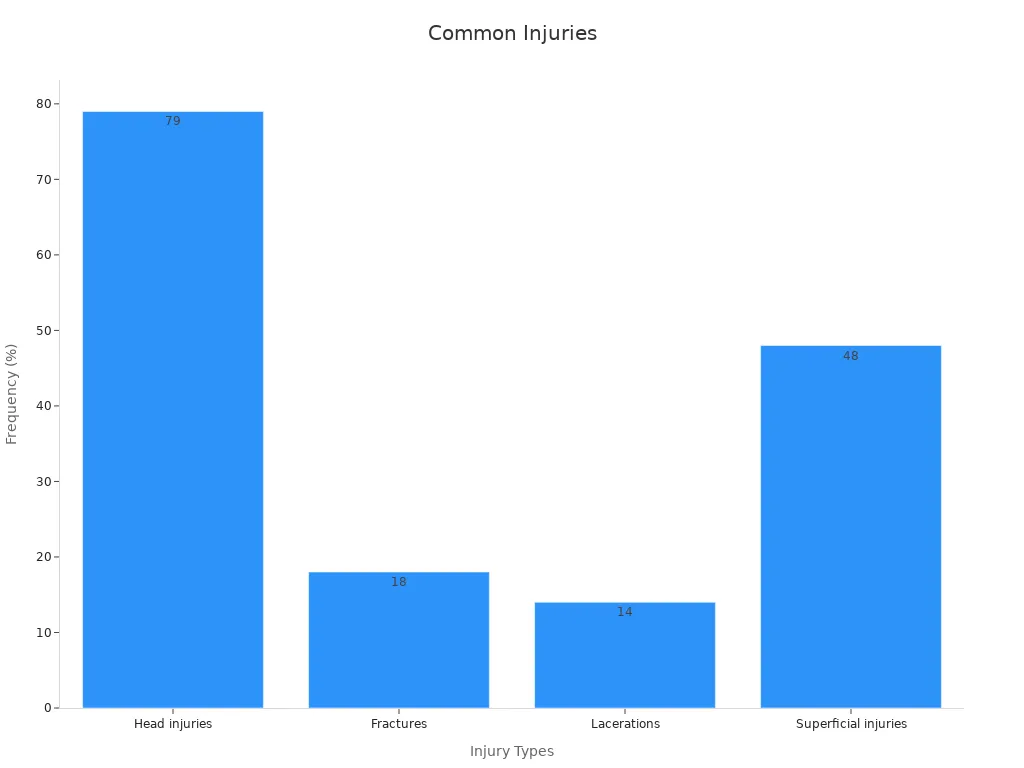Safety Considerations and Smart Alternatives for Riding in Shopping Carts

Riding in a shopping cart may seem fun for your child, but real dangers exist. Every day, 66 children in the U.S. visit emergency departments for cart-related injuries. Take a look at these numbers:
Statistic Description | Data / Value |
|---|---|
Average children treated daily in US EDs | 66 children per day (one every 22 minutes) |
Average children treated annually | Over 24,000 children annually |
Most commonly injured body region | Head (78.1%) |
You want to keep your kids safe, so paying attention to safety considerations matters. Many parents feel concerned about infection risks, too, especially if a baby rides where raw food sits. Shopping safely starts with smart choices, so you can focus on your family.
Key Takeaways
Always place your child in the designated shopping cart seat and use the safety belt to prevent falls and injuries.
Never let children stand, ride in the basket, or hang on the outside of the cart to avoid tip-overs and serious accidents.
Consider safer alternatives like strollers, baby carriers, wagons, or shopping with help to reduce risks during shopping trips.
Wipe down cart seats and handles before use to protect your child from germs and maintain good hygiene.
Supervise your child closely at all times; even a moment of distraction can lead to injuries.
Shopping Cart Safety Risks

Common Injuries
When you put your child in a shopping cart, you might not realize how quickly an injury can happen. Most injuries from shopping carts affect the head and neck. In fact, about 78% of all reported cases involve these areas. Babies and toddlers are especially at risk. A simple fall can lead to a concussion or even a serious injury like a skull fracture.
Take a look at this table to see the most common types of injuries:
Injury Type | Frequency / Percentage | Notes on Mechanism and Age Patterns |
|---|---|---|
Head injuries | Most common injury; includes skull fractures (8%) | |
Fractures | 18% | Includes 5 skull fractures; associated with falls and tip-overs |
Lacerations | 14% | Result from falls or cart tip-overs |
Superficial injuries (ecchymoses, abrasions) | 48% | Common but less severe injuries |
You can see that head injuries top the list. Fractures and cuts also happen often. Even a small bump can turn into a big problem if your child falls from a shopping cart.

Other injuries include bruises, strains, and sprains. These can happen to adults too, but kids face the most danger. Most injuries happen to children under five years old.
Tip: Always check for signs of a head injury after any accident, even if your child seems fine at first.
How Accidents Happen
You might wonder how these injuries occur. Most shopping cart accidents happen in just a few seconds. Here are the main ways children get hurt:
Falling out of the cart: This is the most common cause. Kids often stand up or lean over the edge. About 58% of injuries happen this way.
Cart tip-overs: Sometimes, the whole shopping cart tips over. This happens most often when a child sits in the main basket or climbs on the side. Tip-overs cause about 26% of injuries.
Trips and slips: You or your child might trip over a cart or get hit by one in a busy store.
Improper use: Placing a car seat on top of a cart or letting your child ride in the basket increases the risk.
Pediatric injuries from shopping carts usually happen fast. You may turn away for just a moment, and your child could fall or the cart could tip. Most injuries happen when children stand in the basket or ride on the outside of the cart. Even if you use the seat, a wiggly child can slip out if not strapped in.
Note: Shopping cart safety means always using the seat belt and never letting your child ride anywhere except the designated seat.
Shopping carts are not designed for play. They can roll away, tip over, or cause a serious injury before you even notice. Always keep your child within arm’s reach and use the safety straps every time.
Safety Considerations for Parents
Proper Cart Use
When you shop with your baby or toddler, safety considerations should always come first. You want to make sure your child stays safe, so always place your child in the designated seat of the shopping cart. Never let your children stand up, ride in the basket, or hang onto the outside. These actions can lead to falls or tip-overs.
Always use the safety belt or harness provided.
Never let your children ride anywhere except the seat.
Make sure your child sits down and stays seated the whole time.
Studies show that using proper cart techniques helps keep your infant safe. Research highlights that correct use of restraints, like seat belts, lowers the risk of injury. Injury prevention programs and reminders from stores can help parents remember these safety precautions.
Tip: Never place an infant car seat on top of a cart. This can make the cart unstable and put your infant at risk for a fall.
Hygiene is another important part of safety considerations. Wipe down the seat before you place your child in it. Babies and infants often touch surfaces and put their hands in their mouths, so keeping things clean helps prevent illness.
Supervision and Restraints
You might think that just being nearby is enough, but statistics show that over 90% of shopping cart injuries happen even when a parent is present. Many parents leave their children unattended for just a moment, like when reaching for an item. That’s all it takes for an accident to happen.
Never leave your child alone in the cart, even for a second.
Make sure your child is always buckled in with the restraints.
Watch your infant closely, especially if you have more than one child with you.
Safety precautions matter every time you shop. If you follow these steps, you lower the risk for your baby, toddler, or infant. Remember, never let your children ride in unsafe ways, and always use the seat belt. These simple precautions can make a big difference in keeping your children safe.
Shopping Cart Alternatives

When you want a safer way to shop with your child, you have more options than you might think. Many parents look for shopping cart alternatives that keep their kids secure and make the trip easier. Let’s look at some of the best safe alternatives and how you can use them for a smoother, safer shopping experience.
Strollers and Baby Carriers
Strollers and baby carriers give you a practical way to shop while keeping your baby close. Strollers work well for infants and toddlers. You can buckle your child in, store your bags underneath, and move through the store with ease. Baby carriers let you keep your hands free and your baby snuggled against you. Both options help you avoid the risks that come with shopping carts.
Here are some tips to use these alternatives safely:
Choose a stroller that meets current safety standards. Register it for recall alerts.
Always use the harness straps to secure your child.
Store heavy items in the basket under the stroller, not on the handles. This keeps the stroller from tipping.
Follow the weight and age limits for your stroller or carrier.
Buckle your baby in every time, even for short trips.
Support your baby’s head and neck in a carrier, especially for newborns.
Tip: Never let your baby sleep in a stroller if they are younger than four months. This helps prevent suffocation risks.
While strollers and carriers have their own safety guidelines, they do not have the same high injury rates as shopping carts. Most injuries with strollers happen when parents forget to use the harness or overload the handles. You can avoid these problems by following the tips above.
Wagons and Child-Sized Carts
Wagons and child-sized carts offer another solution for families. Wagons are sturdy and sit low to the ground, which lowers the risk of falls. Many wagons come with seat belts and soft grips. Some even have edge protectors and extra safety features. Child-sized carts, designed just for kids, have adjustable belts and seats that hold your child firmly.
Studies show that these safer shopping carts and wagons reduce accident risks. Features like smooth-rolling wheels and sturdy construction help keep your child safe. Major stores now use these designs to make shopping safer for families. When you use a wagon or a child-sized cart, always buckle your child in and remind them to stay seated.
Note: Never let your child stand or climb in a wagon or cart. This simple rule helps prevent most injuries.
Shopping with Help
Sometimes, the best alternative is to bring another adult or older child along. Shopping with help lets you focus on your list while someone else keeps an eye on your baby or toddler. You can also split up tasks, making the trip faster and less stressful.
If you shop alone, try to plan your trip during less busy times. Some stores offer special carts for families or even have staff who can help you. Don’t be afraid to ask for assistance if you need it.
Callout: Shopping with help is a practical way to shop, especially if you have more than one child or a busy schedule.
Other Modern Solutions
Retailers now use new technology to make shopping safer and easier. Some stores have electronic locking wheels or coin-lock systems to keep carts secure. Others use AI-powered virtual carts that track your items and speed up checkout. These systems improve safety, reduce theft, and make shopping more convenient for everyone.
You might also notice carts made from recycled materials or with ergonomic handles. These features make carts easier to use and better for the environment. Stores design these systems to work smoothly, so you can shop without extra hassle.
Tip: Look for stores that offer these modern alternatives. They often provide a safer and more comfortable shopping experience for you and your child.
By choosing the right alternative, you can keep your child safe and make shopping more enjoyable. Whether you use a stroller, a baby carrier, a wagon, or shop with help, you have plenty of options. Each solution offers a safer way to shop and helps you avoid the dangers of traditional carts.
Essential Shopping Cart Safety Tips
Use of Restraints
When you shop with your child, always use the safety belt or harness in the shopping cart. This simple step can make a huge difference. Research shows that stores with greeters who encourage restraint use and offer a small reward see a big jump in correct restraint use. Take a look at this table:
Measure | Intervention Stores | Nonintervention Stores |
|---|---|---|
Baseline correct restraint use | 15% | 19% |
Post-intervention correct restraint use | 49% | 31% |
Total observations | 416 (approx.) | 551 (approx.) |
You can see that correct restraint use nearly tripled in stores with extra encouragement. Even with these improvements, about half of children still ride unrestrained or not buckled in the right way. So, you play a key role in keeping your child safe.
Tip: Only place your child in the cart seat if they can sit up on their own with good head control, usually around 6 to 9 months old.
Experts also recommend choosing carts designed for children when possible. Always supervise your child and never let them climb or ride outside the cart. These safety precautions help prevent falls and tip-overs.
Hygiene and Maintenance
Shopping carts can carry a lot of germs. Studies found that 72% of carts tested had fecal bacteria. In fact, cart handles can have more germs than many public restrooms. You touch the handle, your child touches the seat, and germs can spread fast.
Wipe down cart handles and seats with disinfecting wipes before you shop.
Use shopping cart covers to add a barrier between your child and the cart.
Wash your hands or use hand sanitizer after shopping.
Remind your child not to touch their face while riding.
Regular cleaning and maintenance of carts in stores also help lower infection risks. Stores that clean carts often have fewer harmful bacteria. If you see a dirty cart, ask for a clean one or use your own cover. These precautions make shopping safely much easier for you and your family.
Note: Good hygiene is just as important as using restraints. Both steps work together to keep your child healthy and safe.
Special Situations
Multiple Children
Shopping with more than one child can feel like a juggling act. You want to keep everyone safe, but it gets tricky when you have a toddler and a baby or two young kids. Most injuries happen when children ride unsafely in carts, especially if you skip the restraint straps or let them sit in the basket. Over 21,000 children under age five end up in emergency rooms each year from shopping cart injuries, and about 75% of those involve the head or neck.
Here are some tips to help you manage:
Buckle each child securely in the cart seat. Never let them ride on the sides or in the basket.
If your baby cannot sit up alone, use a stroller or carrier instead of placing a car seat on the cart.
Only adults should push the cart. Older kids may want to help, but this can lead to tip-overs.
Keep a close eye on everyone. Even a quick distraction can lead to a fall.
Tip: Shopping carts in the U.S. often lack modern safety features. Always double-check the seat and straps before you start shopping.
The American Academy of Pediatrics recommends better cart designs and improved restraint systems. Until stores catch up, your best defense is careful supervision and using the cart as safely as possible.
No Alternatives Available
Sometimes, you have no choice but to use a shopping cart. Maybe you forgot the stroller, or your hands are full. In these moments, the risk goes up. Nearly 66 children visit emergency rooms every day for shopping cart injuries. Most of these happen when safer options—like strollers, wagons, or having kids walk—are not used.
Take a look at the trends:
Year | Estimated Injuries |
|---|---|
2008 | |
2009 | 22,800 |
2010 | 23,300 |
Children under five make up 85% of these injuries, with head and face injuries being the most common. Falls from carts cause about 70% of accidents. Even with safety standards, head injuries have increased in recent years.
If you must use a cart, follow these steps:
Always use the seat belt or harness.
Place only one child in the seat at a time.
Never leave your child unattended.
Avoid letting your child stand or ride outside the cart.
Note: Even when you have no alternatives, your choices matter. Careful supervision and proper use of restraints can help prevent serious injuries.
Shopping cart rides might look harmless, but you face real risks every time. National data shows over 85,000 store injuries each year, with young children hurt most often from falls. Many adults lose sight of their kids while shopping, which raises the chance of accidents.
You can make a difference by choosing safer options and staying alert. Every smart choice helps protect your child. You’ve got this—safe shopping starts with you!
FAQ
What should you do if your child refuses to sit in the cart seat?
Try offering a small toy or snack to keep your child busy. You can talk with your child about why sitting is important. If your child still resists, use a stroller or carrier instead.
Can you use a shopping cart cover for extra safety?
A shopping cart cover adds a layer between your child and the cart. It helps with hygiene but does not prevent falls. Always use the seat belt, even with a cover.
Are there age limits for riding in shopping carts?
Most stores recommend the cart seat for children who can sit up alone, usually around 6 months. Once your child outgrows the seat or cannot fit safely, switch to a stroller or let them walk.
What if your store does not offer child-friendly carts or wagons?
Ask a store employee for help. You can bring your own stroller or carrier. Try shopping during less busy times to make it easier to keep your child safe.
See Also
Uncovering Fatal Risks Associated With Vending Machines Today
Walgreens Self-Checkout Experience: Benefits And Retail Obstacles
Top Nearby Corner Stores You Can Easily Walk To
